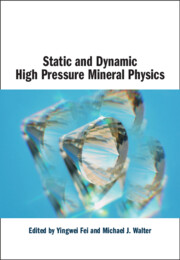Book contents
- Static and Dynamic High Pressure Mineral Physics
- Static and Dynamic High Pressure Mineral Physics
- Copyright page
- Contents
- Contributors
- 1 Introduction to Static and Dynamic High-Pressure Mineral Physics
- 2 Development of Static High-Pressure Techniques and the Study of the Earth’s Deep Interior in the Last 50 Years and Its Future
- 3 Applications of Synchrotron and FEL X-Rays in High-Pressure Research
- 4 Development of Large-Volume Diamond Anvil Cell for Neutron Diffraction: The Neutron Diamond Anvil Cell Project at ORNL
- 5 Light-Source Diffraction Studies of Planetary Materials under Dynamic Loading
- 6 New Analysis of Shock-Compression Data for Selected Silicates
- 7 Scaling Relations for Combined Static and Dynamic High-Pressure Experiments
- 8 Equations of State of Selected Solids for High-Pressure Research and Planetary Interior Density Models
- 9 Elasticity at High Pressure with Implication for the Earth’s Inner Core
- 10 Multigrain Crystallography at Megabar Pressures
- 11 Deformation and Plasticity of Materials under Extreme Conditions
- 12 Synthesis of High-Pressure Silicate Polymorphs Using Multi-Anvil Press
- 13 Investigation of Chemical Interaction and Melting Using Laser-Heated Diamond Anvil Cell
- 14 Molecular Compounds under Extreme Conditions
- 15 Superconductivity at High Pressure
- 16 Thermochemistry of High-Pressure Phases
- Index
- References
2 - Development of Static High-Pressure Techniques and the Study of the Earth’s Deep Interior in the Last 50 Years and Its Future
Published online by Cambridge University Press: 03 August 2023
- Static and Dynamic High Pressure Mineral Physics
- Static and Dynamic High Pressure Mineral Physics
- Copyright page
- Contents
- Contributors
- 1 Introduction to Static and Dynamic High-Pressure Mineral Physics
- 2 Development of Static High-Pressure Techniques and the Study of the Earth’s Deep Interior in the Last 50 Years and Its Future
- 3 Applications of Synchrotron and FEL X-Rays in High-Pressure Research
- 4 Development of Large-Volume Diamond Anvil Cell for Neutron Diffraction: The Neutron Diamond Anvil Cell Project at ORNL
- 5 Light-Source Diffraction Studies of Planetary Materials under Dynamic Loading
- 6 New Analysis of Shock-Compression Data for Selected Silicates
- 7 Scaling Relations for Combined Static and Dynamic High-Pressure Experiments
- 8 Equations of State of Selected Solids for High-Pressure Research and Planetary Interior Density Models
- 9 Elasticity at High Pressure with Implication for the Earth’s Inner Core
- 10 Multigrain Crystallography at Megabar Pressures
- 11 Deformation and Plasticity of Materials under Extreme Conditions
- 12 Synthesis of High-Pressure Silicate Polymorphs Using Multi-Anvil Press
- 13 Investigation of Chemical Interaction and Melting Using Laser-Heated Diamond Anvil Cell
- 14 Molecular Compounds under Extreme Conditions
- 15 Superconductivity at High Pressure
- 16 Thermochemistry of High-Pressure Phases
- Index
- References
Summary
Development of static high-pressure techniques over the last 50 years is reviewed from the perspective of the study of the Earth’s deep interior. Fifty years ago, laboratory high-pressure and -temperature experiments were limited to the conditions corresponding to that of near the surface of the Earth. In high-pressure mineral physics, extension of the pressure range directly made possible the study of deeper parts of the Earth, and many scientists spent great effort to improve various experimental techniques. As a result, currently it is possible to do precise X-ray experiments at the conditions corresponding to the center of the Earth: 6,400 km depth from the surface, about 360 GPa, and more than 5,000 K. Two quite different types of high-pressure apparatus are widely used these days. One is the large-volume high-pressure apparatus, and the other is the diamond anvil cell. Although the latter has the advantage of covering wider pressure and temperature conditions together with optical access to the sample, the former has the advantage of much larger sample volume, and, using internal resistance heaters, very stable and uniform high-temperature conditions can be achieved. Many different types of experimental techniques are combined with these high-pressure devices, and rich information about various properties of minerals and melts can now be obtained. Advancement of synchrotron radiation played a key role for such studies, and our knowledge about the Earth’s deep interior has increased considerably. Further efforts are continuing to extend the pressure range beyond the limits of existing high-pressure devices.
- Type
- Chapter
- Information
- Static and Dynamic High Pressure Mineral Physics , pp. 17 - 41Publisher: Cambridge University PressPrint publication year: 2022

